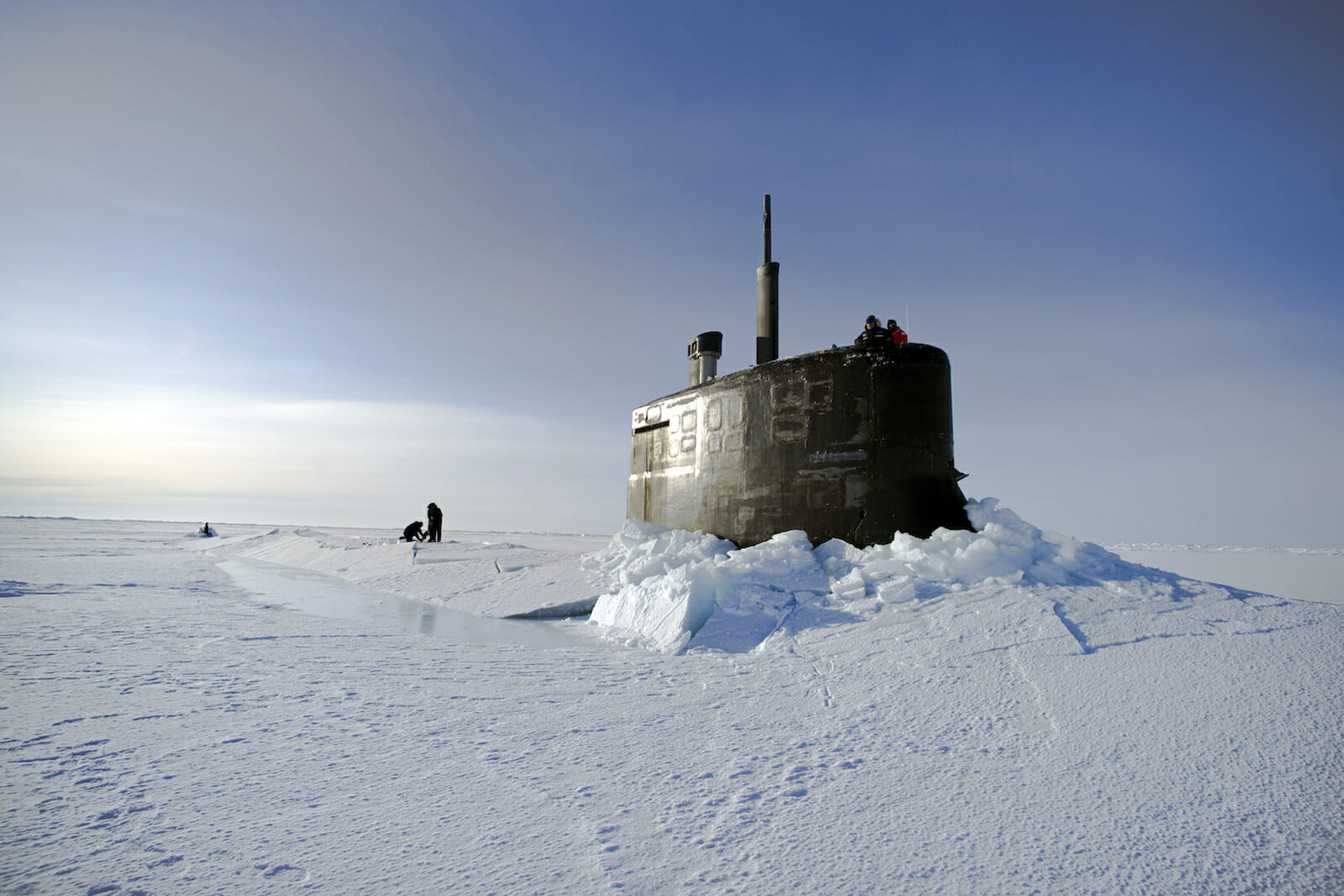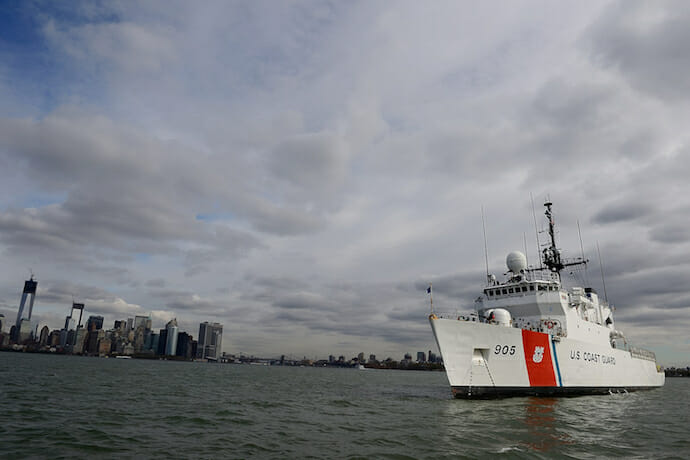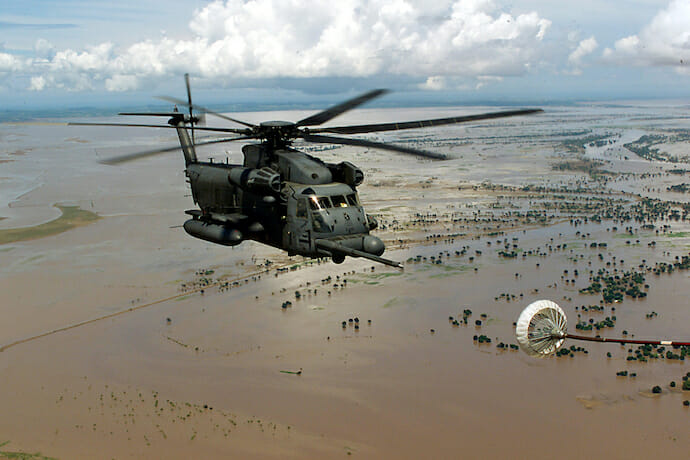
Climate Change and Implications for National Security
“If you wait until you have 100 percent certainty, something bad is going to happen…” – General Gordon R. Sullivan, Retired, former U.S. Army Chief of Staff
Our planet is 4.5 billion years old. If that whole time was to be reflected on a single one-year calendar then the dinosaurs died off sometime late in the afternoon of December 27th and modern humans emerged 200,000 years ago, or at around lunchtime on December 28th. Therefore, human life on earth is very recent. Sometime on December 28th humans made the first fires – wood fires – neutral in the carbon balance.
Now reflect on those most recent 200,000 years again on a single one-year calendar and you might be surprised to learn that the industrial revolution began only a few hours ago during the middle of the afternoon on December 31st, 250 years ago, coinciding with the discovery of underground carbon fuels.
Over 250 years carbon fuels have enabled tremendous technological advances including a population growth from about 800 million then to 7.5 billion today and the consequent demand to extract even more carbon. This has occurred during a handful of generations, which is hardly noticeable on our imaginary one-year calendar. The release of this carbon – however – is changing our climate at such a rapid rate that it threatens our survival and presence on earth. It defies imagination that so much damage has been done in such a relatively short time. The implications of climate change are the single most significant threat to life on earth and, put simply, we are not doing enough to rectify the damage.
This relatively very recent ability to change our climate is an inconvenient truth; the science is sound. We know of the complex set of interrelated national and global security risks that are a result of global warming and the velocity at which climate change is occurring. We worry it may already be too late.
Climate change writ large has informed few, interested some, confused many, and polarized politics. It has already led to an increase in natural disasters including but not limited to droughts, storms, floods, fires etc. The year 2012 was among the 10 warmest years on record according to an American Meteorological Society (AMS) report. Research suggests that climate change is already affecting human displacement; reportedly 36 million people were displaced in 2008 alone because of sudden natural disasters. Figures for 2010 and 2011 paint a grimmer picture of people displaced because of rising sea levels, heat, and storms.
Climate change affects all natural systems. It impacts temperature and consequently, it affects water and weather patterns. It contributes to desertification, deforestation, and acidification of the oceans. Changes in weather patterns may mean droughts in one area and floods in another. Counter-intuitively, perhaps, sea levels rise but perennial river water supplies are reduced because glaciers are retreating.
As glaciers and polar ice caps melt, there is an albedo effect, which is a double whammy of less temperature regulation because of less surface area of ice present. This means that less absorption occurs and also there is less reflection of the sun’s light. A potentially critical wild card could be runaway climate change due to the release of methane from melting tundra. Worldwide permafrost soils contain about 1,700 Giga Tons of carbon, which is about four times more than all the carbon released through human activity thus far.
The planet has already adapted itself to dramatic climate change including a wide range of distinct geologic periods and multiple extinctions, and at a pace that it can be managed. It is human intervention that has accelerated the pace dramatically: An increased surface temperature, coupled with more severe weather and changes in water distribution will create uneven threats to our agricultural systems and will foster and support the spread of insect-borne diseases like Malaria, Dengue, and the West Nile virus. Rising sea levels will increasingly threaten our coastal population and infrastructure centers and with more than 3.5 billion people – half the planet – depending on the ocean for their primary source of food, ocean acidification may dangerously undercut critical natural food systems which would result in reduced rations.

Climate change also carries significant inertia. Even if emissions were completely halted today, temperature increases would continue for some time. Thus the impact is not only on the environment, water, coastal homes, agriculture, and fisheries as mentioned, but also would lead to conflict and thus impact national security. Resource wars are inevitable as countries respond, adapt, and compete for the shrinking set of those available resources. These wars have arguably already started and will continue in the future because climate change will force countries to act for national survival; the so-called Climate Wars.
As early as 2003 Greenpeace alluded to a report which it claimed was commissioned by the Pentagon titled: An Abrupt Climate Change Scenario and Its Implications for U.S. National Security. It painted a picture of a world in turmoil because global warming had accelerated. The scenario outlined was both abrupt and alarming. The report offered recommendations but backed away from declaring climate change an immediate problem, concluding that it would actually be more incremental and measured; as such it would be an irritant, not a shock for national security systems.
In 2006 the Center for Naval Analyses (CNA) – Institute of Public Research – convened a board of 11 senior retired generals and admirals to assess National Security and the Threat to Climate Change. Their initial report was published in April 2007 and made no mention of the potential acceleration of climate change. The team found that climate change was a serious threat to national security and that it was: “most likely to happen in regions of the world that are already fertile ground for extremism.” The team made recommendations from their analysis of regional impacts which suggested the following. Europe would experience some fracturing because of border migration. Africa would need more stability and humanitarian operations provided by the United States. The Middle East would experience a “loss of food and water security (which) will increase pressure to emigrate across borders.” Asia would suffer from “threats to water and the spread of infectious disease.” In 2009, the CIA opened a Center on Climate Change and National Security to coordinate across the intelligence community and to focus policy.
In May 2014, CNA again convened a Military Advisory Board but this time to assess National Security and the Accelerating Risk of Climate Change. The report concludes that climate change is no longer a future threat but occurring right now and the authors appeal to the security community, the entire government, and the American people to not only build resilience against projected climate change impacts but to form agreements to stabilize climate change and also to integrate climate change across all strategy and planning. The calm of the 2007 report is replaced by a tone of anxiety concerning the future coupled with calls for public discourse and debate because “time and tide wait for no man.”
The report notes a key distinction between resilience (mitigating the impact of climate change) and agreements (ways to stabilize climate change) and states that:
Actions by the United States and the international community have been insufficient to adapt to the challenges associated with projected climate change. Strengthening resilience to climate impacts already locked into the system is critical, but this will reduce long-term risk only if improvements in resilience are accompanied by actionable agreements on ways to stabilize climate change.
The 9/11 Report framed the terrorist attacks as less of a failure of intelligence than a failure of imagination. Greenpeace’s 2003 account of the Pentagon’s alleged report describes a coming climate Armageddon which to readers was unimaginable and hence the report was not really taken seriously. It described:
A world thrown into turmoil by drought, floods, typhoons. Whole countries rendered uninhabitable. The capital of the Netherlands submerged. The borders of the U.S. and Australia patrolled by armies firing into waves of starving boat people desperate to find a new home. Fishing boats armed with cannon to drive off competitors. Demands for access to water and farmland backed up with nuclear weapons.
The CNA and Greenpeace/Pentagon reports are both mirrored by a similar analysis by the World Bank which highlighted not only the physical manifestations of climate change, but also the significant human impacts that threaten to unravel decades of economic development, which will ultimately foster conflict.
Climate change is the quintessential “Tragedy of the Commons,” where the cumulative impact of many individual actions (carbon emission in this case) is not seen as linked to the marginal gains available to each individual action and not seen as cause and effect. It is simultaneously huge, yet amorphous and nearly invisible from day to day. It is occurring very fast in geologic time terms, but in human time it is (was) slow and incremental. Among environmental problems, it is uniquely global. With our planet and culture figuratively and literally honeycombed with a reliance on fossil fuels, we face systemic challenges in changing the reliance across multiple layers of consumption, investment patterns, and political decisions; it will be hard to fix!
Despite some of the dramatic climate events of the last several years, climate change remains formless in the public mindset. While there is certainly a component of denial, what now goes hand in hand with the perception of climate change is a plethora of information sources accentuated by a proliferation of marketing, advertising, manipulation, and also distortion. In this world, each citizen can self-select the message that most conveniently suits him and the generalized result has all-too-often been to place blame on oil companies, politicians, and/or scientists. Because it is such a large and complex issue, the real danger is having the message fragmented and thus dissolved into singular events and small issues.
Arguments about climate change have become rigidly ideological and often split across broad constituencies of rich and poor. Importantly, the people who currently live in climate environments that are already nearly unbearable and those who live in areas most likely to be impacted are not generally the people who are making environmental policy.
This is a losing war of attrition which disaggregates the focus, minimizes the impacts to all but a small crowd of issue stalwarts, and undermines the effectiveness of responses.

Assaults on the climate change front have benefited from tactics successfully used to delay tobacco regulation, where planting the seeds of doubt tends to be more productive and plausible than outright denial. Nowhere else on earth would a suggestion on what kinds of light bulbs to buy result in charges of “socialism,” or that a move toward electric vehicles be interpreted as a slap on macho sensibilities. In a manner of cognitive dissonance that would be comical if it were not so perverse. Resistance to climate change action is becoming defined not by the science or observed impacts, but by denial, distortion, and a generalized hand-wringing that the cost of resilience is too high and that achieving agreements for stabilization is impossible.
Governments recognize that something should be done but have approached the whole problem somewhat unconvincingly. The U.S. was initially supportive of climate change action and helped develop the United Nations Framework Convention on Climate Change (UNFCCC). In 1992, it joined over 180 other nations in signing the Convention and continued to work in development of the Kyoto Protocol to bring UNFCCC to implementation. But, in 1998, the Senate voted 95-0 to reject commitments by the U.S to participate.
Ironically, reported U.S. emissions have declined slightly in the last five years, due to both to recession and the unanticipated market presence of vast quantities of cheap natural gas – from fracking (water pressure to create fractures in rock to extract oil and gas) which has expanded 5-fold since 1990 and displaced coal. While Europe has made a brave effort at implementation of its European Trading Scheme analogue, the framework has been weakened by recession and by a growing unwillingness to go it alone.
Regardless of U.S. reluctance to seriously engage in the admittedly difficult task of establishing a global resilience framework, and an agreement to stabilize and accept the associated cost, the consequences of inaction are larger and much more difficult to reverse. To effectively address climate change, the current political logjam, public sentiment, and resistance by big business must be broken. Without a global resilience framework underpinned by agreements from at least a critical mass of large emitter nations, efforts to slow climate change will remain dangerously fragmented. The CNA report notes that:
Concern over the potential for climate change impacts on our national security – regardless of the cause – has diminished as a national issue and politically charged debate has silenced sound public discourse … we believe that congressional action is warranted – and it is needed now. Neither the DoD, nor any other agency, can act alone to address the impacts of climate change.
We hope the recent CNA report which is linked directly to hard-hitting national security policies and priorities will break the phalanx of existing in-the-box thinking about climate change. While Pentagon officials appear to be acknowledging the severity of climate risks, it should be cautioned that a focus on resilience locally like building higher walls to avoid storm damage, and protect domestic resources, is inadequate because a truly global environmental set of threats cannot be contained on a local basis. Current U.S. efforts are an impotent counterbalance to our overall failure to significantly reduce our emissions and also to accept emission agreements in general.
The U.S. should lead a global framework morally, physically, and conceptually. A true leadership role for the U.S. would be to step up and reach out to help all countries not just to build higher walls to protect our interests. Even if countries resist, we must keep pressing forward. For instance, the Arctic will likely melt and thus become as much a tragedy of the commons as the global interstate of the Asia-Pacific region – better named the Indian Ocean Region – which drew a significant change in U.S. Defense Policy in early 2012 under President Obama’s so-called pivot/rebalancing initiative.
While the issue is polarizing in domestic politics, it is in the larger context between rich and poor nations where required responses on a humanitarian and relief basis will not only strain military resources, but also create an increasingly untenable position for military responders. Regardless of how relatively successful security responses are on a per-event basis, it will likely not absolve the U.S. of blame in the eyes of those receiving the assistance. Thus, an approach relying on localized resilience remains fundamentally short-sighted for what is a global threat. The security system was not designed with such tasks in mind and we will find ourselves wanting if these issues are not truly addressed now.
It is recommended that the U.S.:
Seek congressional authorization and appropriation to form a Cabinet-level agency, the Department of Climate Control (DCC), appointing a Secretary and consolidating the relevant existing climate change components across the U.S. government. DCC should be included through a Presidential policy directive within the national security and interagency decision-making process in a manner similar to the Department of Homeland Security (DHS) but unlike DHS – as there is not time – it must be organized, given authority, responsibility and funds to support dynamic and inclusive problem resolution to match the urgency of the crisis faced.
Frame, resource and deliver a whole menu of U.S. Government strategy for climate control – Global Climate Control Leadership to Save our Planet – to take action to:
Inform the American people; achieve resilience to the effects of climate change by elevating it to the highest echelons of national security challenges; stabilize climate change through agreements in order to prevent its acceleration. In particular, take measures to restrict emissions and tax carbon while fostering similar approaches overseas; and, mentor overseas partners to achieve strategic coherence with the American-led global climate change strategy and offer tangible and innovative resilience measures.
In all we do, we should strive to lead, guide, and mentor the world to secure a better future for our children and future generations. The noble task for a credible world leader is to work to preserve not just our planet, but the human condition, culture, and complex interrelationships that exist here. If we have not damaged our planet beyond repair already, we now have the opportunity to address the crises. In so doing, we must engage across the globe and bring others along with us to achieve a sustainable environment and a future for the human race.
The views expressed in this article are those of the authors alone and do not necessarily represent the official policy or position of the NESA Center, National Defense University, the Department of Defense, the World Bank, or ENDESA.

